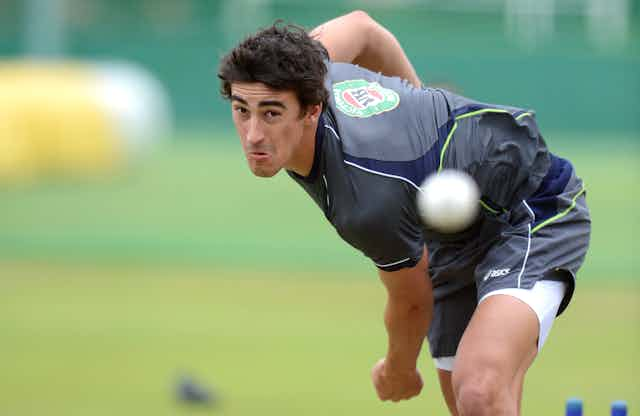Another Ashes cricket series is upon us and, once again, all the talk is about who has the most potent bowling attack. But, of course, injuries can thwart the best laid plans – so how can biomechanics help?
Last year, England’s Australian-born bowling coach, David Saker, stated that England’s bowlers - all of whom are due to play in the forthcoming series - were the best in the world and rather mischievously proclaimed they were “as good as” the great Australian bowling attack of McGrath, Warne, Lee and others.
A few weeks ago, the now ex-coach of Australia, Mickey Arthur, boasted his current crop of bowling talent was the “best all-round bowling attack in world cricket” and capable of regaining the Ashes urn that has been in England’s possession since their historic series win Down Under in 2010-11.
Although current statistics suggest Australia’s bowling attack undoubtedly has the potential to be world-leading, at the moment it remains just that - potential. Except for the resilient Peter Siddle, the rest of Australia’s fast bowling battery continues to be debilitated by injury, despite the much-publicised precautions taken by Cricket Australia to manage workloads.
Among all the talk on rotation policies - “informed player management” as Cricket Australia likes to call it - the role of the bowler’s action in the cause of injury has seemingly been overlooked. Although bowling injuries, specifically those to the lower back, are evidently multifactorial, research has consistently shown “poor” technique is the most prominent contributor to injury.

The mixed bowling action - characterised by a counter-rotation or realignment of the thorax to a more side-on position during the delivery stride - has traditionally been thought to predispose bowlers to lumbar spine and intervertebral disc injuries.
But recent research in England and Australia using more sophisticated motion capture technology and musculoskeletal models has indicated a combination of excessive trunk lateral flexion and pelvis axial rotation - the “crunch factor” as it has been dubbed - may be more instrumental in the cause of lower back injury.
From research to application
How effective this biomechanical research has been in terms of actually reducing the incidence of injury in fast bowlers, however, remains unclear.

Certainly some ex-players and pundits remain sceptical, not only about the practical application of this research, but also the merit of biomechanists in the coaching process more generally. Indeed, some are worried about the “cloning” of fast bowlers, while others have become so frustrated by the constant, seemingly detrimental, tinkering of bowlers’ techniques they’ve suggested that biomechanists should be sent back to the laboratories where they belong.
While this criticism may sound harsh and somewhat overdramatic, it is not entirely without justification. There have been instances over the past decade when previously healthy fast bowlers have been encouraged to change their action on the promise they will attain even higher levels of performance with reduced likelihood of injury, only for the opposite to occur.
England’s Jimmy Anderson is a classic case in point. He was deemed to have a potentially injurious action shortly after bursting onto the international scene in 2002-03, but following a period of remodelling, Anderson sustained a stress fracture to his back - the very injury his new technique was supposed to guard against. Since reverting back to his old idiosyncratic style, he has rediscovered his pace and confidence, been rarely injured, and has recently become England’s all-time leading wicket-taker in one day international cricket.
To put into perspective how difficult it is to identify injury mechanisms and predict their occurrence, consider research on lower-extremity running injuries. In contrast to the tens of papers on lower back injuries in fast bowling - a recent systematic review suggested that the number of high-quality papers may be even lower - there have been literally hundreds on lower extremity running injuries but yet the mechanisms underpinning running injuries are still hotly debated and, importantly, been shown to be somewhat individual-specific.
The amount of pronation - the inward rolling of the foot at heel strike - has long been associated with injury but there are many runners who exhibit what might be termed “excessive pronation”, while few have reported any related injuries. By contrast, there are other runners who exhibit “normal” amounts of pronation who have histories of chronic lower extremity injuries.
Individual differences
The individual-specific nature of injury mechanisms, I believe, is one of the major barriers to fully understanding and predicting injuries in fast bowlers. Each bowler has their own unique set of characteristics - “constraints” as they are termed in contemporary motor-control theory - that will, in part, dictate their susceptibility to injury.
Biomechanists must be innovative in their thinking, be prepared to adopt alternative research designs, and work beyond their usual paradigms to better understand these constraints and uncover the true causes of injury for individual fast bowlers. Fast bowling coaches must also be patient and recognise there is no one-size-fits-all solution to either injury or performance.
In the meantime, injury may yet prove a deciding factor in whether the current crop of Australian bowling talent will be enough to be “the best all-round bowling attack in the world” and regain the Ashes from England.

